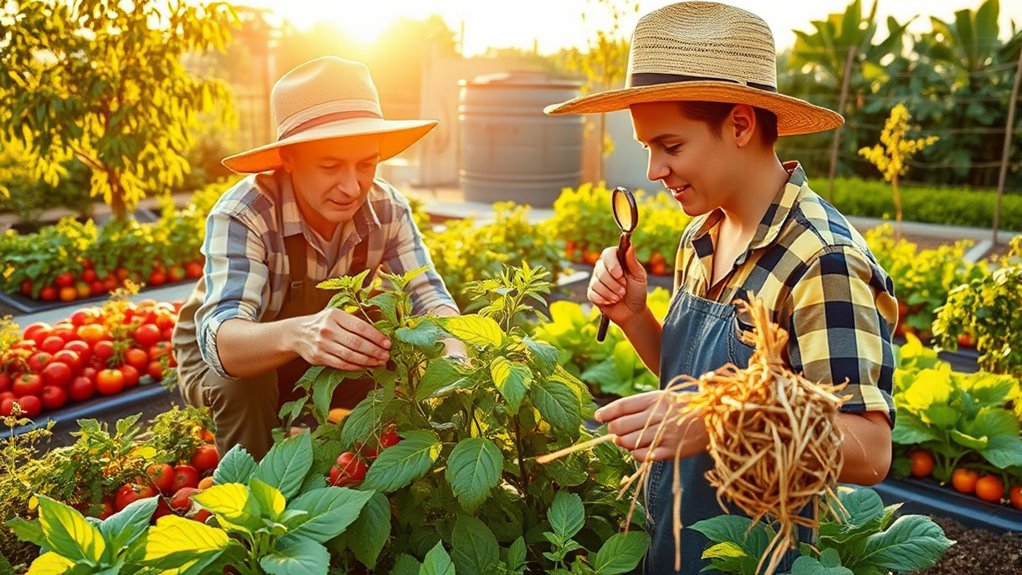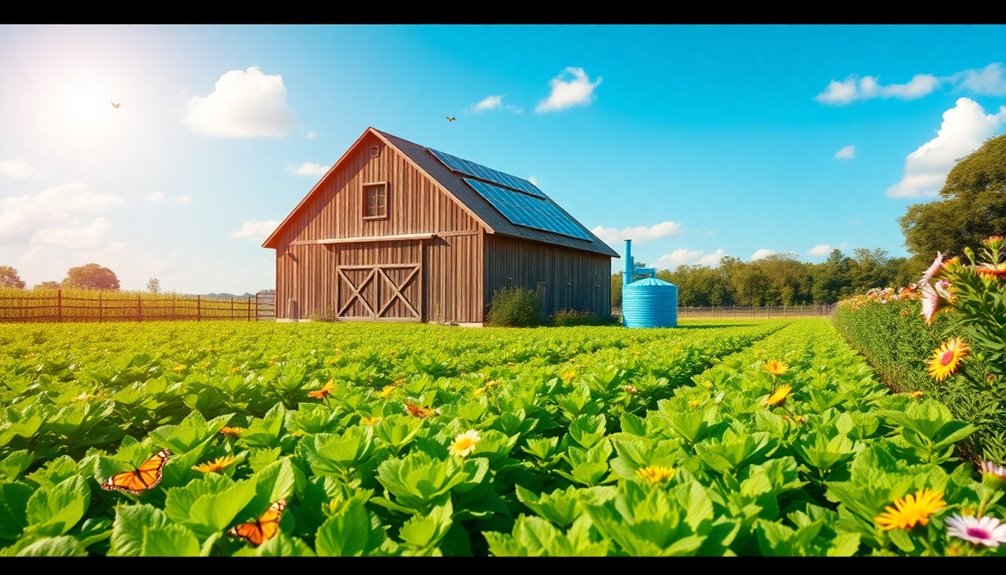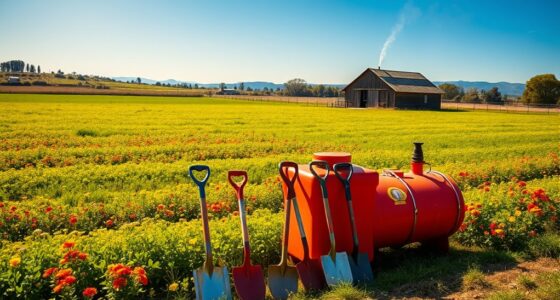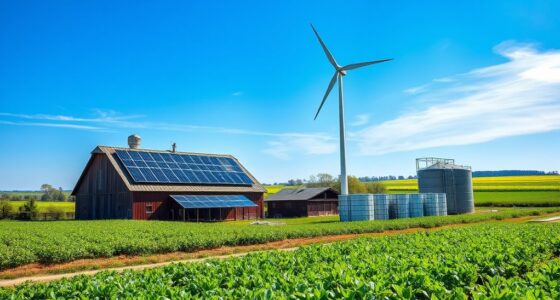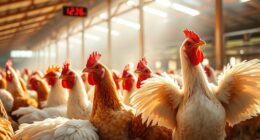Integrated Pest Management (IPM) for small farms combines natural pest control methods, regular monitoring, and targeted actions to keep pests at manageable levels. By using beneficial insects, trapping, and timely inspections, you can diminish reliance on chemicals and promote a healthier environment. This approach helps prevent pesticide resistance and supports biodiversity. Staying proactive and data-driven ensures sustainable and cost-effective pest control. Keep exploring to discover how you can implement these strategies effectively.
Key Takeaways
- Implement regular pest monitoring to detect early infestations and inform targeted control actions.
- Use biological controls like beneficial insects to naturally reduce pest populations.
- Establish economic pest thresholds to determine when intervention is necessary, minimizing unnecessary pesticide use.
- Promote sustainable practices such as crop rotation and habitat management to support ecosystem health.
- Keep detailed records of pest activity and control measures to improve future pest management strategies.
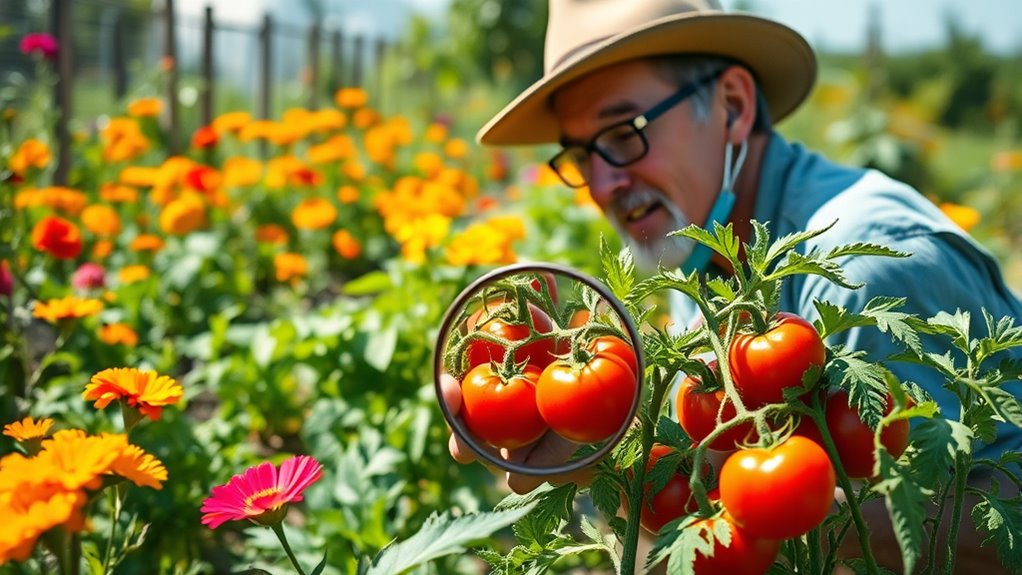
Have you ever wondered how farmers and gardeners keep pests under control without relying solely on chemicals? The answer lies in integrated pest management (IPM), a strategic approach that combines various methods to manage pests effectively and sustainably. One of the foundational elements of IPM is biological controls, which involve using natural enemies like beneficial insects, birds, or microorganisms to suppress pest populations. These allies help keep pests in check without the environmental and health risks associated with chemical pesticides. But before introducing biological controls, pest monitoring becomes essential. Pest monitoring involves regularly inspecting your crops to identify pest presence, population levels, and damage. This process helps you determine whether pest levels are approaching or exceeding economic thresholds, guiding timely and targeted interventions.
When you practice pest monitoring, you’re actively gathering data on pest activity and population dynamics. This might include setting up traps, visually inspecting plants, or using simple tools like magnifying glasses. The goal is to catch pest outbreaks early, before they cause significant damage. Accurate monitoring allows you to make informed decisions about when and how to deploy biological controls or other methods. For example, if monitoring reveals a surge in aphids, you might introduce lady beetles or lacewing larvae, which are natural predators of aphids. These biological controls work by preying on pests, reducing their numbers naturally, and maintaining a balance within your ecosystem. Incorporating pest thresholds as a decision-making tool can further enhance your management strategy by helping you determine when pest levels require action.
Using pest monitoring also helps you avoid unnecessary pesticide applications, which can harm beneficial insects and lead to pesticide resistance. Instead, you target pest problems only when they reach a level that warrants action, making your pest management efforts more sustainable and cost-effective. Additionally, adopting data-driven strategies can optimize your pest control efforts by providing measurable results and guiding future decisions. Regular record-keeping of pest populations and control measures can further improve your strategies over time. Incorporating integrated methods like crop rotation and habitat management alongside biological controls can improve the overall success of your pest management plan. Incorporating monitoring techniques that utilize modern tools can also increase the accuracy and efficiency of your pest detection efforts.
In small farms, where resources are limited, this approach is especially valuable. It encourages a proactive mindset—spotting issues early and responding with natural solutions rather than reactive, chemical-heavy tactics. With consistent monitoring and the judicious use of biological controls, you can keep pest populations in check while supporting biodiversity and protecting your soil and water quality. This integrated approach not only safeguards your crops but also aligns with environmentally responsible farming practices, ensuring your farm remains productive and sustainable for years to come.
Frequently Asked Questions
How Does IPM Differ From Conventional Pest Control Methods?
You might wonder how IPM differs from conventional pest control methods. Unlike traditional approaches that rely heavily on chemical reliance and frequent pesticide use, IPM emphasizes eco-friendly strategies. You’ll identify pests early, target them with specific methods, and reduce pesticide dependence. This approach minimizes environmental impact, protects beneficial insects, and promotes sustainable farming. You actively manage pests instead of just applying chemicals, leading to healthier crops and safer food.
What Are the Initial Costs of Implementing IPM Practices?
Did you know that initial costs for IPM can range from $50 to $200 per acre? You’ll need to do a cost analysis and incorporate these expenses into your budget planning. While some tools and training might seem pricey upfront, they often save money long-term by reducing pesticide use. Starting small and gradually expanding your IPM practices helps manage costs and makes implementation more affordable.
Can IPM Be Effective for Organic Small Farms?
You might wonder if IPM can work for organic small farms. The good news is, IPM is highly effective for organic compatibility, focusing on natural pest suppression methods like biological controls and crop rotation. It reduces reliance on chemicals, making it ideal for organic practices. By implementing IPM, you can manage pests sustainably, protect your crops, and maintain your farm’s organic integrity while keeping pest levels under control.
How Do Weather Conditions Influence IPM Strategies?
Weather patterns and climate variability substantially influence your pest management strategies. Changes in temperature, humidity, and rainfall affect pest life cycles and crop vulnerability, so you need to adapt your approaches accordingly. For example, wetter conditions may promote fungal diseases, while drought can stress plants, making them more susceptible to pests. By monitoring weather forecasts and understanding local climate trends, you can time interventions more effectively and minimize pest damage.
What Training or Resources Are Needed for Small Farm Adoption?
Imagine stumbling upon a small farm thriving despite pests—that’s thanks to farmer education and resource accessibility. To adopt effective strategies, you need targeted training programs that cover pest identification, eco-friendly controls, and record-keeping. Accessible resources like online guides, local workshops, and extension services bolster your confidence. This combination guarantees you’re equipped to implement sustainable practices, helping your farm stay productive and environmentally responsible.
Conclusion
Think of IPM like tending a garden with a gentle hand—you catch pests early, like spotting weeds before they take over. I once saw a small farm reduce pesticide use by 50% simply by introducing natural predators and crop rotation. Just as a skilled gardener nurtures healthy plants while keeping pests at bay, you can protect your farm sustainably. Embrace IPM, and you’ll foster a thriving, resilient farm that flourishes naturally.

